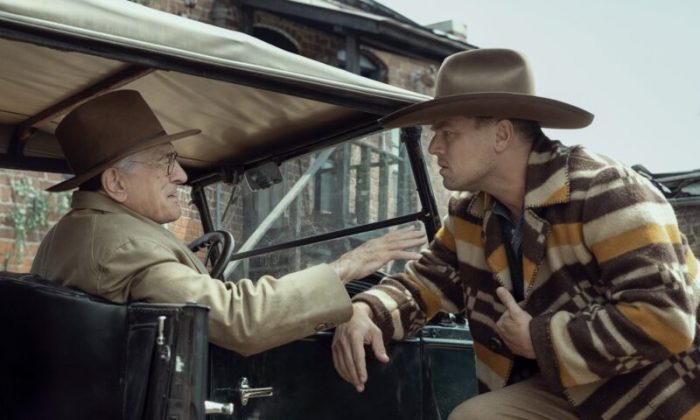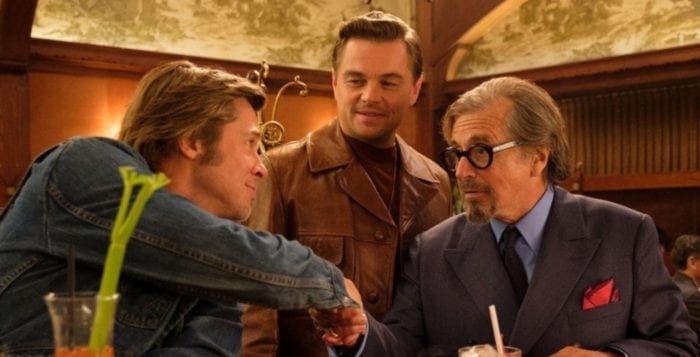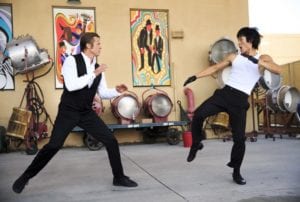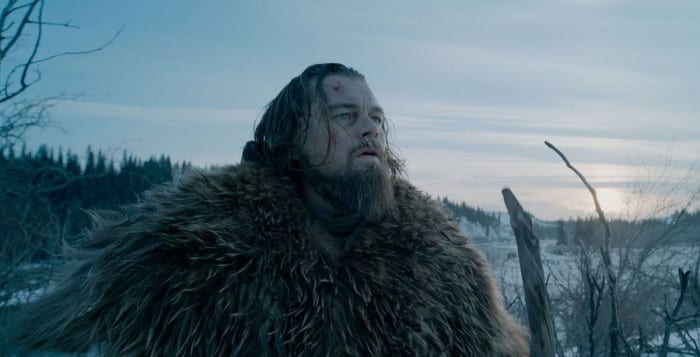Reviewed by Jeffrey Sanzel
David Grann’s true-crime Killers of the Flower Moon: The Osage Murders and the Birth of the FBI brilliantly chronicles the Reign of Terror that cut a blood-stained swath through the Osage tribe in Oklahoma in the early 1920s. Two dozen murders were directly attributed to the four-year period, but further inquiry revealed a larger conspiracy that spanned at least two decades and hundreds of homicides. The book was one of the best or most notable books of 2017 by The New York Times, Wall Street Journal, Washington Post, Time, NPR, and many others.
Members of the Osage Nation earned royalties from oil sales through their federally mandated “head rights.” As the oil market grew, many amassed wealth, leading to widespread swindles and violence on the unsuspecting Native Americans. In addition, the Burke Act (1906) imposed an unscrupulous situation of guardianships, depriving many of the Osage control over their money making them wards of predatory opportunists.
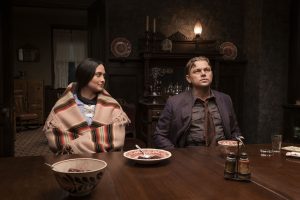
The book’s narrative is one of poisonings, shootings, and even the bombing of a house. The history is fraught with coverups by local authorities, high-profile citizens, police, doctors, and even undertakers. Coercion, blackmail, and negotiations with criminals are all part of the byzantine tapestry. The country found little sympathy for the victims, instead focused with a morbid glee on the lurid details: “Osage Indian Killing Conspiracy Thrills,” heralded the Reno Evening Gazette.
With over forty films (including multiple documentaries), Martin Scorsese’s extraordinary roster includes Mean Streets, Alice Doesn’t Live Here Anymore, Taxi Driver, Raging Bull, Goodfellas, The Age of Innocence, Casino, The Departed, The Wolf of Wall Street, and, his last film, 2019’s The Irishman. The Award-winning director has co-written the screenplay for Killers of the Flower Moon with Eric Roth (Forrest Gump, Munich, The Curious Case of Benjamin Button, and A Star Is Born). The result is a compelling epic.
The story alternates between wider brutality and intimate moments among a trio of first-rate actors, surrounded by a varied, if not fully developed, supporting cast. Clocking in at nearly three and a half hours, Killers of the Flower Moon is a powerful, important film, but surprisingly misses some of the broader and significant elements of the story.
The film opens with a ritual burying of a peace pipe in a meditative and communal ceremony. Set to a pulsing soundtrack, the action shifts to an almost orgasmic oil gush, segueing into a portrait of the Osage, who became the world’s richest people per capita.
The scene changes to Fairfax, Oklahoma. While it is the 1920s, the town seems more a portrait of Wild West chaos, contrasting the wealthy Native Americans with an earthy population of white speculators and oil workers.
Ernest Burkhart (Leonardo DiCaprio) returns from Europe, where he served as an infantry cook in World War I, and his uncle, William King Hale (Robert De Niro), takes him in. Hale, the self-titled King of the Osage Hills, is a friend and supporter of the Osage, speaking the language and moving with ease in their community. The façade is quickly dispelled as Ernest is drawn into Hale’s machinations of deception and vicious, destructive manipulations. With his sly, paternal benevolence, he advises Ernest not to make small but big trouble—for there lies the big payoff.
While driving a cab, Ernest meets and courts Osage Mollie Kyle (Lily Gladstone). Much of the film is shown through her eyes and heard in her brief voiceovers, simply and devastatingly enumerating the many uninvestigated tribal murders. After their marriage, Hale continues to involve Ernest in a range of illegal and immoral activities, resulting in the death of Mollie’s sisters.
Scorsese and Roth have narrowed the scope, focusing mainly on Ernest, Mollie, and Hale, allowing for extraordinary performances. DiCaprio has never been better as the conflicted but easily swayed Ernest, who becomes one of the “squaw men,” the lay-about husbands living off their wives’ money. DiCaprio shows Ernest’s struggle, creating a character of active and passive complicity but still revealing lingering shreds of humanity.
Lily Gladstone is a revelation of nuance and subtle dimension, finding joy, pain, humor, and strength. Her ability to project extraordinary shades of emotion in complete stillness is matched by her anguish in the film’s most gut-wrenching scenes of loss. Late in the film, her declaration that “this blanket is a target on our backs” reflects a woman robbed of peace of mind, living in a world crumbling from within and without.
De Niro balances the “great white father” with the darkness of a conscienceless villain whose lack of moral compass tips towards the amoral. De Niro (and the film) might have been better served by a gradual revelation of Hale’s true colors, something in which the book succeeds.
As for the rest of the players, there are no weak links, but they have only one or two notes to play. The rogues are rough, whiskey-soaked outlaws. The citizens of Fairfax carry a certain generic “oldy-timey” vibe. The members of the Bureau of Investigation (the forerunner to the FBI) are a tight-lipped crew, directed by Agent Tom White, an effective Jesse Plemons. While a good portion of Grann’s book deals with the investigation under J. Edgar Hoover, the film truncates the inquiry. The trial itself is abbreviated, with John Lithgow, as Prosecutor Leaward, and Brendan Fraser, as W.S. Hamilton, Hale’s attorney, basically serving their functions.
Throughout, the wrongs committed against the Osage are rightly and unflinchingly highlighted. Whether being overcharged for funeral arrangements, targets of arson and insurance fraud, or treated with disdain, suspicion, and envy by the “buzzards circling [the Osage] community,” the Osage nobility is fully present. Never caricatured, their ascendency from victim to the pursuit of justice in the face of systematic murder creates the core of the film’s final stretch.
Scorsese’s penultimate scene is fascinating, allowing a seeming gimmick to work on another level (as it is fact-based). His cameo is fun, if a bit jarring. Killers of the Flower Moon’s final image, a contemporary nod, is beautiful—the ideal resolution to a film that casts light on a bloody, scarred chapter of American history.
Rated R, the film is now playing in local theaters and will later play on Apple TV+.

